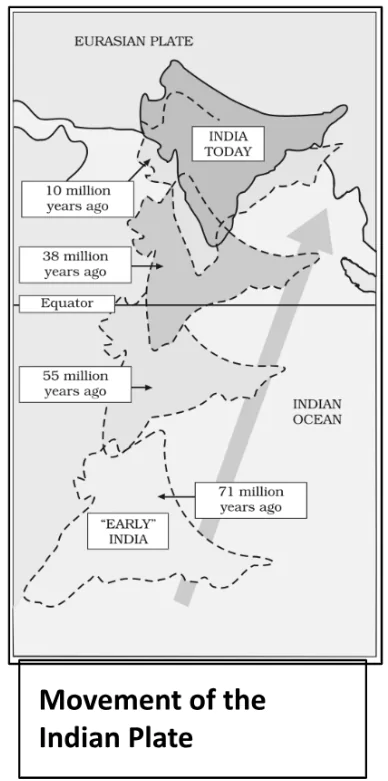The Indian Plate, originally part of the supercontinent Gondwana, embarked on a northward trajectory around 200 million years ago, eventually converging with the Eurasian Plate approximately 40-50 million years ago. As delineated by plate tectonic theory, this collision triggered the monumental uplift of the Himalayas, evidenced by frequent seismic activity. Concurrently, the eruption of lava forming the Deccan Traps underscores the dynamic geological processes shaping the Indian subcontinent within the framework of plate tectonics.
Understanding Plate Tectonics
- Origin: Plate tectonics, a new idea, came after we found out about seafloor spreading, making us curious about how continents and oceans fit together. McKenzie, Parker, and Morgan each came up with the idea in 1967, and it changed how we think about Earth’s surface.
- Plate Tectonics Meaning: Plate tectonics, a fundamental concept in geology, explains how the Earth’s lithosphere is shaped by dynamic processes.
- It proposes that the Earth’s surface is divided into large, rigid plates that drift atop the semi-fluid asthenosphere.
- These plates move due to internal heat-driven forces like mantle convection and gravity.
- Plate boundaries, where plates interact, are zones of intense geological activity, such as earthquakes, volcanoes, and mountain building, offering clues about the Earth’s geological history.
- Driving Force Behind Plate Movement
- Instead of the once-held notion of a static planet, modern understanding acknowledges the Earth’s dynamic nature.
- Plates are propelled by the gradual circulation of the mantle beneath them, known as convective flow, fueled by heat from radioactive decay and residual heat.
- Composition and Thickness of Plates: The lithosphere encapsulates the crust and the upper mantle.
- Thickness varies from 5-100 km in oceanic regions and stretches up to 200 km in continental zones.
- Continental vs. Oceanic Plates: A plate’s classification as ‘continental’ or ‘oceanic’ depends on which type dominates it.
- Example: The Pacific plate is mainly oceanic, while the Eurasian plate is predominantly continental.
- Tectonic Plate Interaction and India’s Geology
- Division of Plates: The world is divided into 7 major plates and several small tectonic plates that interact with each other along their boundaries.
- Example: Eurasian Plate, Indo-Australian Plate, the Arabian Plate, and the African Plate.
- Location of India: India is situated on the Indo-Australian Plate, which is a major tectonic plate that includes the entire Indian subcontinent and extends into the Indian Ocean.
- Interaction of Indian Plate: The collision between the Indian Plate and the Eurasian Plate is responsible for the formation of the Himalayan mountain range.
- This collision has also resulted in significant seismic activity in the region, including earthquakes and the formation of geological features such as the Deccan Traps.

Movement of the Indian Plate
- India’s Geological History: India, situated near the Australian landmass, was separated from Asia by the Tethys Sea until around 225 million years ago.
- Approximately 200 million years ago, peninsular India began moving northward. (When Pangea broke)
- About 40-50 million years ago, India collided with Asia, leading to the rapid uplift of the Himalayas.
- The ongoing collision continues to raise the height of the Himalayas.
- Indications of Tectonic Plate Movement: Evidence of the northward movement of the Indian tectonic plate against the Asiatic plate is seen through frequent earthquakes in the region.
- Deccan Traps: During the movement of the Indian plate towards the Asiatic plate, a significant event occurred with the eruption of lava, forming the Deccan Traps.
Enroll now for UPSC Online Course
Indian Plate Boundaries:
- Northern Boundary: The Himalayas represent a continent-continent convergence zone.
- Eastern Boundary: Extends from the Rakinyoma Mountains to the Java Trench, featuring a spreading site near Australia in the SW Pacific.
- Western Boundary: Begins at the Kirthar Mountains, stretches along the Makrana coast, and connects to the Red Sea rift via the Chagos Archipelago.
- Southern Boundary with Antarctica: Defined by an oceanic ridge that merges near New Zealand.
Conclusion
The journey of the Indian Plate, from separating from Gondwana to colliding with Asia, illustrates Earth’s dynamic geological processes. Seismic activity and formations like the Himalayas and Deccan Traps underscore plate tectonics’ pivotal role in shaping India’s landscape. The ongoing collision with the Eurasian Plate highlights Earth’s ever-changing surface. Studying plate movements provides valuable insights into our planet’s geological history and evolutionary forces.
![]() April 27, 2024
April 27, 2024
![]() 6276
6276
![]() 0
0
